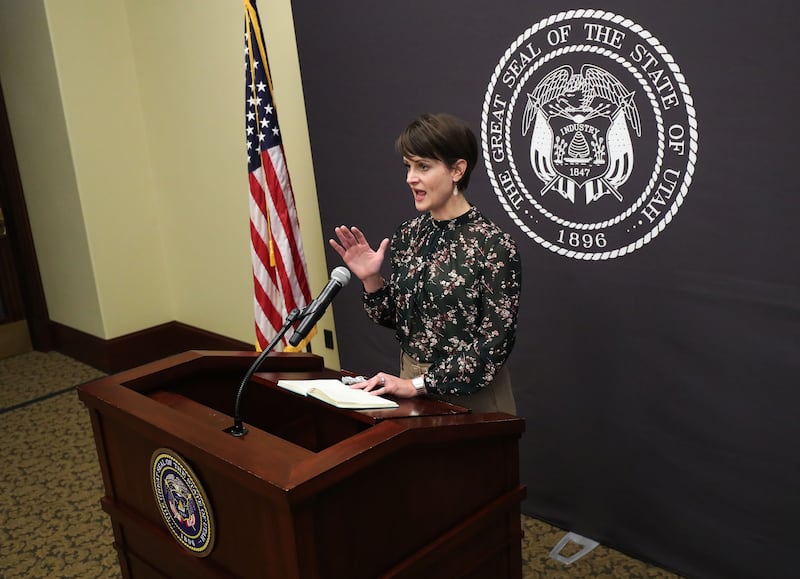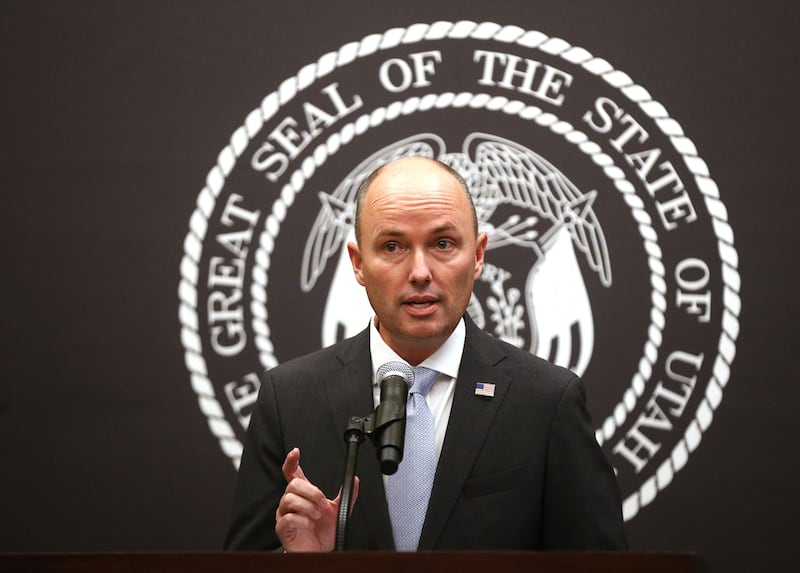SALT LAKE CITY — Gov. Spencer Cox announced Friday he intends to speed up COVID-19 vaccinations in Utah, targeting those 70 and older as well long-term care facility residents, saying he’s disappointed the state’s effort to date has fallen short.
As the governor was detailing the plan laid out in an executive order, Utah reported 3,793 new COVID-19 cases, topping the 300,000 mark, and added 22 people to the state’s death toll, including six deaths that occurred before Dec. 21.
A total of 89,431 vaccine doses had been reported administered as of Friday, less than half of the just under 199,000 doses that have been delivered to the state since the first shipments arrived at Salt Lake-area hospitals in mid-December, according to the Utah Department of Health.
“That’s still far below where we should be at this point,” the governor said at his first news conference on the deadly virus since taking office. Cox, who helped direct the state’s response as lieutenant governor, said he’s made no secret of his disappointment and delivered what he called an urgent message to health officials.
“There is nothing more important in all of our careers collectively than what we are doing right now. This is what the world has been waiting for. This is what we will be judged by, our ability to get these lifesaving and career saving and economy saving and health saving drugs out to the people who need them the most,” Cox said.
“It is unacceptable to have vaccines sitting on the shelf and moving forward, I assure you, there will be no vaccines sitting on a shelf,” he said of the state’s allocation from the federal government of about 30,000 vaccine doses weekly.

Now, the governor said, vaccine distribution will be managed by the state’s 13 local health districts, which have the capabilities of administering a minimum of 50,000 doses a week and possibly double that number. He said he expects the districts to move fast enough to run out of vaccines.
Monday, teachers and staff will be eligible to be vaccinated, and Cox said he hopes to see those who are older or who have underlying health conditions taken care of first. Starting Jan. 18, he said every Utahn age 70 or older will be able to be vaccinated — a change from the previously announced age limit of 75 years old.
Vaccinations in long-term care facilities are being handled by pharmacy chains that have contracted with the federal government, as well as community health organizations. Cox said facilities will be required to report the number of doses administered daily and those that fail to reach their goals will see their allocations shifted.
By the end of the day Friday, the governor said vaccines will have been administered to residents and staff in 153 of the state’s 353 long-term care facilities, about 9,000 doses total, and all of the facilities should be completed by Jan. 23.
It may take until the end of February to vaccinate the estimated 240,000 Utahns who are at least 70, and all of the 172,000 or so others on the state’s priority list. Cox said the state will then move on to Utahns who are at least 65 years old, and those with yet-to-be-announced underlying conditions.
Just when the vaccine will become available to all Utahns has yet to be determined, but he said the hope is that his plan for picking up the pace means it will be sooner than anticipated. The state’s timeline had suggested it could take until July.
The most vulnerable Utahns should be vaccinated first, the governor said. Utahns who have already tested positive for COVID-19 in the past 90 days should not be vaccinated since they are unlikely to be reinfected, a restriction Cox said should be extended to six months.
Utah’s minority communities will not be prioritized separately, even though Latinos and others have seen higher rates of the virus. But there will be vaccination sites located in minority communities to avoid “the same mistakes we made early in the pandemic without having testing sites available in those areas,” the governor said.
Cox said Utah will not delay a second dose of the current pair of vaccines approved for use in the United States. President-elect Joe Biden said Friday he favors releasing the available vaccine so more people can get a first dose rather than holding back enough to ensure the second doses are available.
He said he has “no immediate plans” to make changes to the restrictions on counties that the state has put in place, which include requiring masks in public, social distancing and limiting the size of gatherings to as few as 10 people, based on the level of transmission.
Both the governor and state epidemiologist Dr. Angela Dunn urged Utahns to take those measures against the virus.
“It’s clear we’ve let our guard down,” Dunn said, referring to the post-holiday spike in cases. “There is a lot of excitement about the vaccine, but we need to come together again. We need to focus on what we can do as individuals to protect our hospitals by preventing the spread of COVID.”
Earlier Friday, Salt Lake County Mayor Jenny Wilson said the county is vaccinating first responders and other groups identified by state officials as quickly as possible.
“I’m really happy to report today that Salt Lake County has this under control,” Wilson told reporters during a news conference outside the Salt Lake County Government Center. “You all, the public, will be receiving a vaccine. What we can’t give you today is a date and we ask for your patience. We’re organizationally prepared.”

The mayor said the supply of the vaccine is limited, but county health officials are able to respond to increased doses “at a moment’s notice.”
Gary Edwards, Salt Lake County Health Department executive director, said the county is doing what it can.
“The supply is not great. We are getting doses in arms quickly. The doses we have available to us are either in arms or committed through next week,” Edwards said, adding that “we plan to have doses for anyone who wants a dose but that’s going to take time.”
It’s the state that is receiving the vaccines allocated by the federal government based on population, and it’s the state that has determined the order in which Utahns will be vaccinated, starting with front-line hospital workers in mid-December, long-term care facility residents and staff, emergency workers and first responders.
Teachers and school staff are up next and appointments for their vaccinations are already being made through the county and local school districts, Salt Lake County health officials said.
There have been 13,036 more people tested for the virus in Utah since Thursday, and the rolling seven-day averages for positive tests is 3,051 per day, and a very high 32.7% for the percent of positive laboratory tests.
Hospital intensive care units remain at capacity with 543 people currently hospitalized with COVID-19.
To date, 1,381 Utahns have died from the virus. The latest deaths are:
- Two Washington County men, one between the ages of 65 and 84 and the other between 45-64, both of whom were hospitalized when they died.
- A Davis County woman, 65-84, hospitalized at time of death.
- A Davis County man older than 85 who lived in a long-term care facility.
- Two Davis County men, one between 25 and 44 and the other 45-64 who were both hospitalized at time of death.
- A San Juan County woman, 25-44, who was not hospitalized at time of death.
- A Weber County man, 45-64, not hospitalized.
- Two Utah County men between 65 and 84, one who was hospitalized and another who was in a long-term care facility when they died.
- A Utah County woman, 65-84, hospitalized at time of death.
- A Salt Lake County woman, 45-64, hospitalized at time of death.
- Three Salt Lake County women, 65-84, all hospitalized.
- Two Salt Lake County men, both 65-84, one who was hospitalized and the other living in a long-term care facility when they died.
- Two Salt Lake County women older than 85, one who was hospitalized and one who was not.
- Three Salt Lake County men older than 85, two of whom were not hospitalized and one who was in a long-term care facility when they died.


